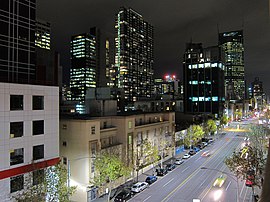La Trobe Street Latrobe Street | |
|---|---|
 | |
| La Trobe Street at night, June 2010 | |
 | |
| General information | |
| Type | Street |
| Length | 2.4 km (1.5 mi) |
| Opened | 1839 |
| Former route number | |
| Major junctions | |
| West end | Harbour Esplanade Docklands, Melbourne |
| East end | Carlton, Melbourne |
| Location(s) | |
| Suburb(s) | Docklands, Melbourne CBD |
La Trobe Street (also Latrobe Street[1]) is a major street and thoroughfare in the Melbourne central business district, Victoria, Australia. It runs roughly east–west and forms the northern boundary of the central business district. The street was laid out as an extension of the original Hoddle Grid in 1839 and was named after Charles La Trobe.[2] La Trobe Street extends from Victoria Street in the east to Harbour Esplanade in the west.
Location
[edit]La Trobe Street is home to a number of precincts and public and private spaces. The Carlton Gardens lie at the eastern end of the street, and the western end terminates at Victoria Harbour in the Docklands. Before Docklands was developed, La Trobe street terminated just beyond its intersection with Spencer Street. In 2000 the La Trobe Street Bridge opened to connect the street through to Docklands, and tram lines were also extended accordingly.[3]
The Flagstaff Gardens are located at the corner of La Trobe and King Streets.
Notable buildings
[edit]Numerous notable buildings and structures on La Trobe Street are listed on the Victorian Heritage Register and/or classified by the National Trust of Australia. These include:
Victorian Heritage Register
[edit]- Argus Building (NMIT)*
- Cast Iron Public Urinal (adjacent to Melbourne Magistrates' Court)*
- Francis Ormond Building (RMIT)*
- Flagstaff Gardens*
- Foresters' Hall*
- Royal Society of Victoria*
- St David's Welsh Church*
- William Angliss College*
- Royal Mint (Former)*
- State Library of Victoria*[4]
*Also classified by the National Trust
National Trust
[edit]- Burton Livery and Bait Stables
- E W Tilley Building
- Statue of Francis Ormond (artist Percival Ball)[5]
Other notable buildings
[edit]- Docklands Stadium
- Melbourne Central Shopping Centre
- Family Court complex
- RMIT University complex
- Aurora Melbourne Central
In recent years there has been controversy over the number of proposed demolitions for unlisted heritage buildings, including:
- 488 La Trobe Street, a Victorian-era workshop built in 1882 (set to be demolished to for a new apartment tower)[6]
- 48 La Trobe Street, a coach factory built in 1862 and added to in 1887 (demolished for a small shopping plaza and laneway access)[7]
Transport
[edit]Two underground railway stations lie beneath La Trobe Street, with Flagstaff station toward the west and Melbourne Central nearer the centre. Two of Melbourne's tram routes travel along La Trobe Street. These are the route 30 and the City Circle tram.
See also
[edit]References
[edit]- ^ Register of Geographic Names, searchable online at[permanent dead link]
- ^ "Melbourne's Streets and Lanes" (PDF). History Victoria. Royal Historical Society of Victoria. Archived from the original (PDF) on 19 March 2018. Retrieved 16 January 2017.
- ^ Victoria, Places (9 September 2014). "Docklands history". www.places.vic.gov.au. Retrieved 16 January 2017.
- ^ "VHD". vhd.heritagecouncil.vic.gov.au. Retrieved 25 January 2017.
- ^ "VHD". vhd.heritagecouncil.vic.gov.au. Retrieved 25 January 2017.
- ^ Lucas, Clay (21 September 2016). "Heritage activist pushes for more protection, vows to stop 'Demolition Doyle'". The Age. Retrieved 16 January 2017.
- ^ Lucas, Clay (29 May 2016). "It has stood for 150 years. Now, it will be replaced by a laneway". The Age. Retrieved 16 January 2017.